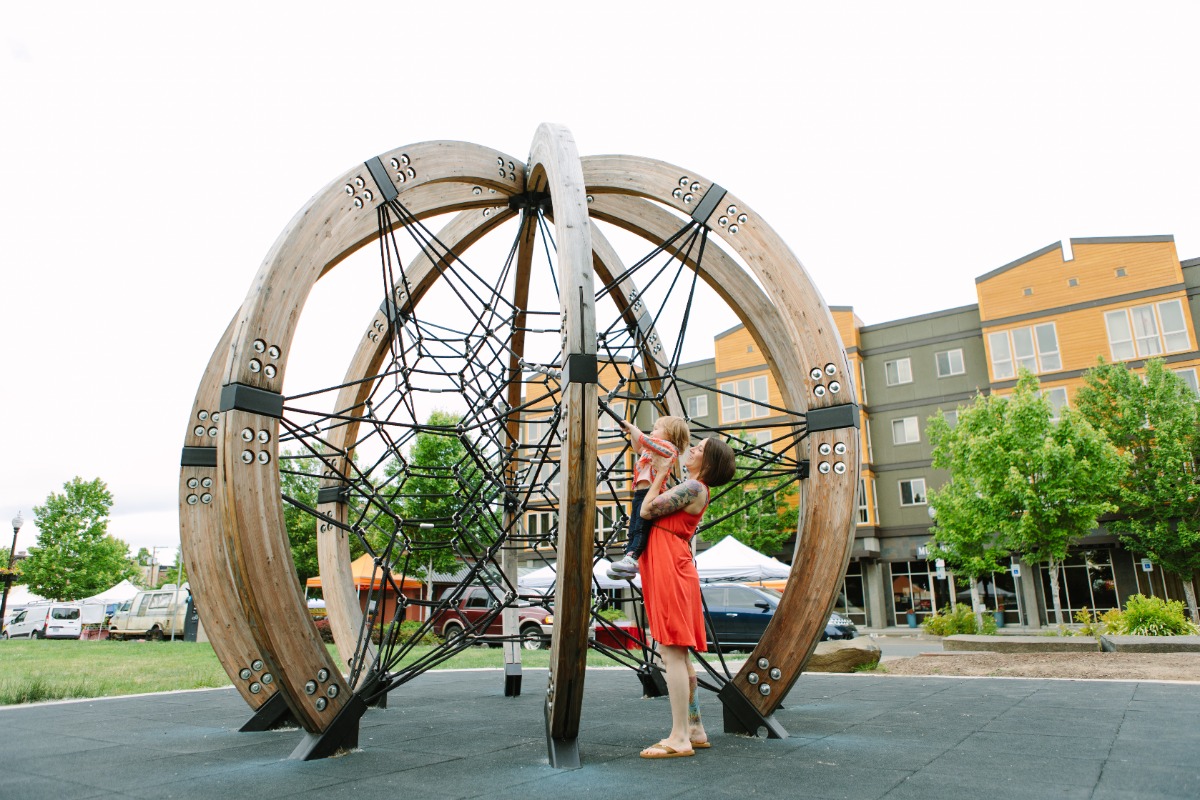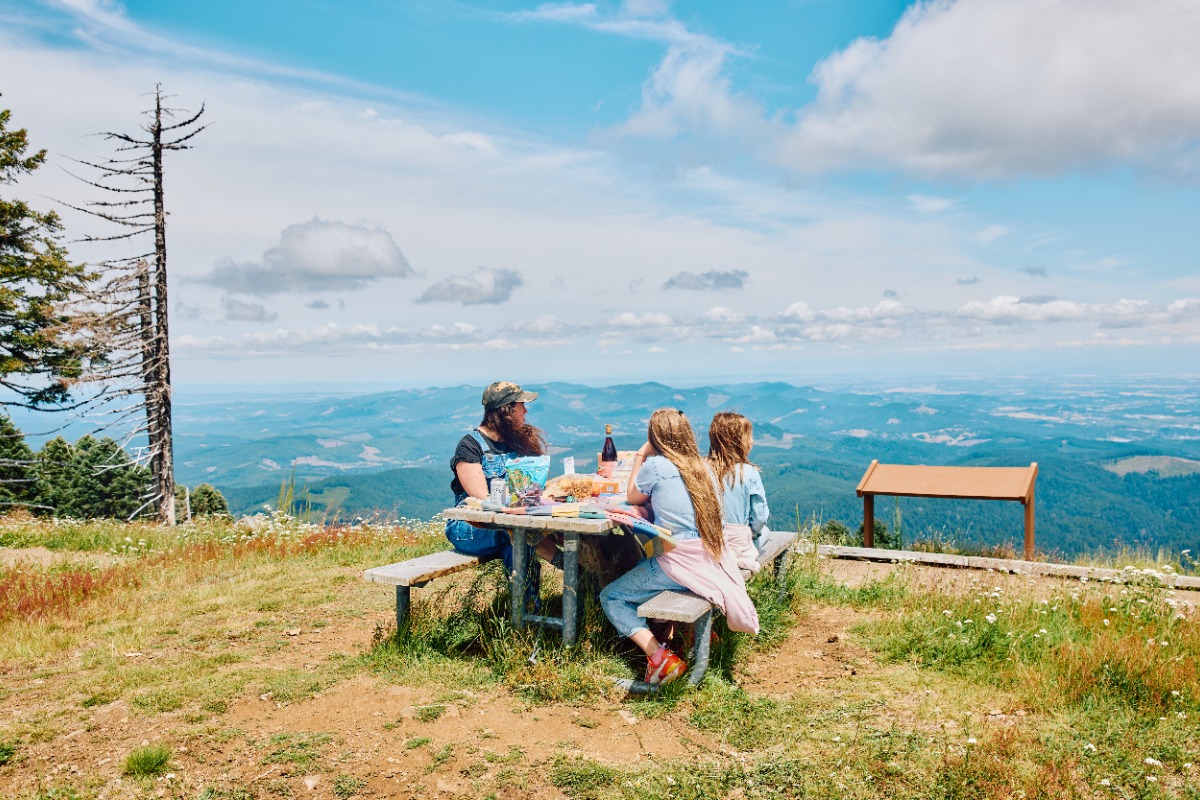Stops Along the Marys Peak to Pacific Coast Scenic Byway: Siuslaw National Forest
A drive along the Marys Peak to Pacific Coast Scenic Byway leads you through Siuslaw National Forest, a breathtaking display of ecological diversity and natural wonders.
The Siuslaw National Forest stretches from the lush forests of the coastal mountains to the unique Oregon Dunes and the beaches of the Pacific Ocean, providing a huge array of opportunities to discover and explore the outdoors. Go hiking, biking, camping, swimming, fishing, and more in this beautiful temperate rainforest.
 Siuslaw River, Florence, Oregon, by J. A. Uppendahl
Siuslaw River, Florence, Oregon, by J. A. Uppendahl
Siuslaw National Forest's History
The land around the Siuslaw National Forest is the ancestral homeland of the Wusi’n people. Today, the land is managed by the U.S. Forest Service. The founding of the U.S. Forest Service has its roots in the early conservationists of the late 19th century, like the first Chief of the U.S. Forest Service, Gifford Pinchot, whose mission was to conserve millions of acres of forest lands for future generations.
The Siuslaw National Forest’s history is inextricably tied to President Theodore Roosevelt and Gifford Pinchot. President Roosevelt, working with Mr. Pinchot, first set aside the land that would become the Siuslaw National Forest as part of the "midnight forests.” In 1907, Oregon Senator Charles W. Fulton introduced an amendment to a bill that would take away the President’s power to create new National Forests. President Roosevelt and Mr. Pinchot franticly created new forest reserves all over the western United States up until “midnight” the night before the bill was signed. Included in the “midnight forests,” were the Tillamook and Umpqua Forest Reserves, which would later be joined to create the 630,000-acre Siuslaw National Forest.
National Forests are traditionally named after their central landscape feature. The Siuslaw National Forest is named after the Siuslaw River, which is one of the forest’s major natural features that flows through the Coast Range into the Pacific Ocean.
The words "Siuslaw," "Tillamook," and "Umpqua" are all derived from indigenous names for places. It's believed by some members of the Confederated Tribes of Coo, Lower Umpqua, and Siuslaw Indians that "Siuslaw" was originally the local name for a small stream entering the North Fork of the Siuslaw River near a major winter village. The name "Siuslaw" evolved to eventually identify multiple different tribes living in this area, the language they shared, the river that supported their culture, the watershed that created the river, and the National Forest that perpetuates its name.
For early Siuslaw National Forest Rangers, just travelling through the large, remote forest along 200 miles of rugged coastal mountains was an incredible challenge. There were no roads and it was easier to go up the broad estuaries of rivers like the Alsea, where tidewater flows up to 20 miles inland.
Duties of the first Forest Service Rangers included forest inspection, fighting fires, and checking homestead claims. Another important role was reforestation. Planting started in 1908, and in the 1930’s, the Civilian Conservation Corp (CCC) crews planted trees in burned and logged-over lands, as many large, widespread fires burned throughout the West in 1910. At one point, sixteen fires burned at one time in the Siuslaw Forest. Rangers had to assemble local crews or try single handedly to hold the fire line.
The Siuslaw National Forest also played a role in supplying materials for military airplanes during World War I. Sitka spruce from coastal forests, with a high strength-to-weight ratio, provided the ideal wood to build some of the first airplanes used in combat. The U.S. Army "Spruce Division" was the first large-scale use of motor vehicles in the Pacific Northwest. Remnants of their old roads and railroads are still visible in the Siuslaw Forest today.
 A northern spotted owl watches from a tree branch, by Georgia Evans.
A northern spotted owl watches from a tree branch, by Georgia Evans.
Siuslaw National Forest's Ecology
The Siuslaw National Forest extends over half a million acres from forest floor to ocean shore! The Coast Range mountains are known for their dramatic scenery and dense, temperate rainforests. Their diverse habitats include mountain meadows, rocky shores, vast sand dunes, and rivers that flow to the Pacific Ocean. Siuslaw National Forest has places in which to immerse yourself in each of these ecosystems.
Storms off the Pacific Ocean blast the steep slopes and sharp ridges of the Coast Range in winter months with over 100 inches of annual rainfall. This creates one of the most productive forests in North America. Upwelling ocean currents, summer fog, and a year-round mild climate create a temperate rainforest containing more living mass than any other forest type.
Giant trees like Sitka Spruce, Douglas Fir, and Western Hemlock can hold gallons of water from the wet winters. Sitka Spruce grow only in a narrow strip along the coast where there are mild temperatures and dense fog. The Sitka Spruce is one of North America’s largest conifers and can grow to more than 200 feet (60 meters) tall. You can see Western Hemlock growing in the shade beneath dense Douglas Fir tree canopy. These majestic conifer trees are just one part of a vast, interconnected system of soil, fungi, lichen, plants, bacteria, and animals. The forest understory is a thick tapestry of ferns, salal and evergreen huckleberry, draped with colorful lichens and moss. Hidden under the soil, decay from dead plants and trees feeds forest regeneration.
Siuslaw National Forest is known for its role in conservation of late successional forests and its 35,000 acres of spectacular "old growth." A late successional forest has a composition of species that will remain essentially unchanged without disturbance. Old growth forests are characterized by ancient trees, standing and fallen, and their diversity of structure and species. Such forests were once far more widespread, and new scientific understandings make us appreciate their immense value in sustaining life.
Old growth forests are critical habitat for rare and threatened species, including the well known northern spotted owl. The marbled murrelet is a threatened seabird that forages out in the ocean but returns to the forest to nest in the high limbs of large trees. These forests are also home to lesser known species such as the red tree vole that lives its entire life in the forest canopy, and the Lobaria oregana, a lichen/fungus that rains down nitrogen to the forest floor. Some scientists have suggested that the old growth canopy is comparable to coral reef habitats in the oceans, where living organisms support not just themselves, but also provide the structure on and around which a host of other organisms can grow, hide, and feed to survive.
 Siuslaw National Forest, Marys Peak, Corvallis, Oregon, by Gail Johnson.
Siuslaw National Forest, Marys Peak, Corvallis, Oregon, by Gail Johnson.
Siuslaw National Forest: Present Day
According to Gifford Pinchot, the first Chief of the U.S. Forest Service, the goal of the National Forests is to, "Provide the greatest good for the most people in the long run... Without natural resources, life itself is impossible. From birth to death, natural resources, transformed for human use, feed, clothe, shelter, and transport us. Upon them we depend for every material necessity, comfort, convenience, and protection in our lives."
Over a century later, Siuslaw National Forest is furthering Mr. Pinchot’s vision through its mission focused on restoration, recreation, and partnerships.
In a single day in Siuslaw National Forest, you can travel from waterfalls to estuaries, hike or ride to the top of sand dunes, view whales from windswept coastal headlands, hike through the depths of ancient forest, kayak on or fish in coastal lakes, or follow mountain streams to where the waves thunder against rocky shores and search for agates on the beach. Hundreds of miles of trails, numerous campgrounds, visitor centers, scenic areas, scenic botanical areas, national recreation areas, and the solitude of four wilderness areas are all within this forest.
The incredible variety of recreational experiences you can have in the Siuslaw National Forest are due to the diversity of natural habitats that the Forest Service and local community partners work to restore and protect. Through partnerships, they are returning natural functions to altered landscapes and focusing on creating and maintaining healthy ecosystems. Siuslaw National Forest management focuses on restoring healthy, diverse, natural forests through an innovative forestry practices, which provide both ecological and economic benefits. Watershed restoration projects improve aquatic habitat for threatened and sensitive species, like the coho salmon, restore natural stream functions, and improve native plant diversity. One current project is in the wind-swept sands of the Oregon Dunes, located further south along the coast. The Oregon Dunes are a unique and inspiring landscape that is vanishing due to the rapid spread of invasive species.
The Siuslaw National Forest works with a broad network of partners and stakeholders through the Oregon Dunes Restoration Collaborative on a restoration strategy to ensure that the Oregon Dunes survive for future generations.
A Driving Tour from City to Sea: Willamette Valley, Alsea River Valley & More
Come with us on a driving tour of one of Oregon’s newest scenic and historic byways. From the highest point in the Coast Range to the broad, sandy beaches of the Central Coast, follow the Alsea River on a delightfully meandering 72-mile driving tour from Corvallis to Waldport.
Article via TravelStorys.com. Featured Photo: Siuslaw National Forest, by Heartwood Films. Keep up with Corvallis news, events and happening by signing up for our email newsletter.











